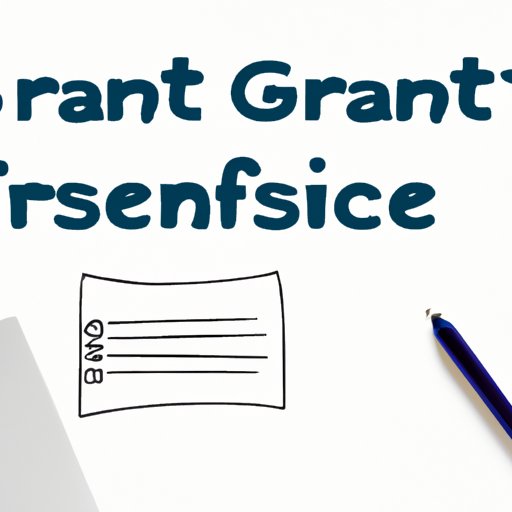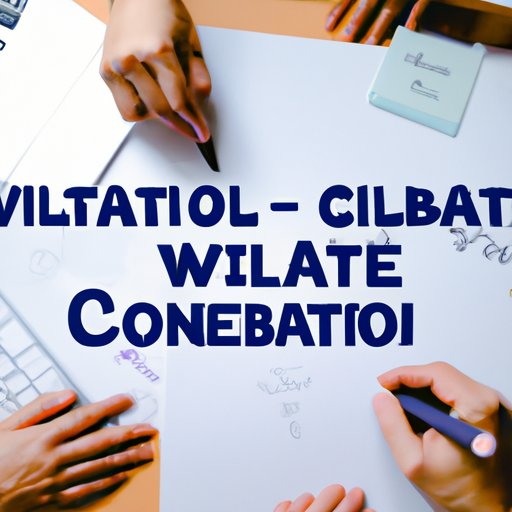
I. Introduction
Are you looking to secure funding for a project, research, or program? Chances are you need to write a grant proposal. A grant proposal is a formal request for financial assistance. It’s a document that outlines a project, program or research, and demonstrates how it aligns with the funding organization’s mission and goals. In this article, we will provide a comprehensive guide on how to write a winning grant proposal that will increase your chances of being funded.
II. Steps for Writing an Effective Grant Proposal
Writing a grant proposal requires a systematic approach that helps in organizing ideas, creating a budget, and outlining your methodology. Here are the steps:
A. Identify the Need
The first step is to identify a significant need that your project or program is addressing. This should be tied to the funding organization’s interest. Identify the problem and how the funding will mitigate it.
B. Create a Project Timeline
Outline and sequence your tasks. Provide a project timeline that shows the project’s goals and milestones, including the start and end date, and how long each stage takes.
C. Outline the Methodology
Outline how the funding will be used and describe the research or project methodology to be used. Show how your approach is unique and effective. Include any partnerships that help leverage your strengths.
D. Budget for Expenses
Create a budget that outlines all the expenses necessary for executing the project. Be realistic and realistic.
E. Review, Revise, and Refine
Revise the grant proposal, refining the ideas and how they align with the funding organization’s goals. Remove ambiguities and proofread for accuracy.
III. Tips for Creating an Impactful Grant Proposal
Writing a compelling grant proposal requires attention to detail and a focus on the strengths of your project.
A. Tell a Compelling Story
Show how your project makes a difference. Highlight the impact of your program and use examples to illustrate how your project is important.
B. Highlight the Project’s Uniqueness
Show how your program is different from the others out there and provide data, research, or statistics to show your innovative approach.
C. Demonstrate its Impact
Provide data or scenarios to help demonstrate the project’s impact or how it will lead to positive changes. Provide comparisons of the current status to the proposed change.
D. Be Passionate and Enthusiastic
Show your passion for the project or program. The enthusiasm and passion can show the reviewer about your confidence in the project and how it can be successful.
E. Incorporate Feedback
Get feedback on your grant proposal before submission. The reviewer’s opinion can be a valuable resource that can help you refine your proposal further.
IV. Common Mistakes to Avoid When Writing a Grant Proposal
Writing a grant proposal can be complicated, but several pitfalls can be avoided.
A. Failure to Follow Directions
Ignore specific requirements or instructions can lead to an immediate rejection of your proposal.
B. Using Jargon
The use of technical terms, acronyms, and jargon can alienate the reviewer and make them not understand your proposal. Avoid using jargon and be clear and concise.
C. Proposing Unrealistic Goals
Be realistic in your goals and show how you will accomplish them. Unrealistic goals can show a lack of understanding and can decrease the chances.
D. Neglecting to Proofread
Grammar and spelling errors can lower the quality of your proposal. Proofread or have someone do a review for you, ensuring every detail is perfect.
E. Ignoring Formatting Guidelines
Not following format instructions can lead to instant rejection. Pay more attention to format guidelines and direct reports.

V. The Power of Collaboration in Grant Writing
Collaboration with other organizations can help strengthen your grant proposal. Here are several ways to build fruitful relationships:
A. Strategies for Identifying Potential Partners
Networking, reaching out to colleagues, and attending conferences can help in identifying potential partners.
B. Building Fruitful Relationships
Effective collaboration means working together and identifying everyone’s strengths. Focus on one’s strengths, and together, create a stronger project.
C. Emphasizing Collaborative Strengths
Show your strengths through collaboration and vocalize the added value it can bring to the project.
VI. Grant Writing for Nonprofits
Writing a grant proposal for nonprofits comes with its unique requirements. Here are several tips:
A. Presenting the Mission Effectively
The mission must be included in your introduction and throughout to stay in focus.
B. Communicating Goals and Objectives
Show how the project or program aligns with your mission. Show how the objectives align with the mission.
C. Demonstrating Organizational Impact
Show how the organizational impact can directly impact the community and use data or case studies to support your claims.
D. Establishing Credibility and Trust
Showcase your organizational credibility, impact, and achievements. Make the reviewers understand that they are making a good investment.
VII. Understanding the Review Process for Grant Proposals
Understanding the review process can help you understand why a grant proposal is accepted or rejected. Here are several things to understand:
A. Evaluation Criteria
The reviewers filter and evaluate proposals based on specific criteria. It is important to understand this to tailor your proposal to align with these assessments better.
B. Reviewer Expectations
The reviewer will look to find unique projects that align with their needs. Get to know them beforehand.
C. Importance of Submission Deadlines
To avoid getting rejected, submit the grant proposal before the deadline. Early submission gives time to have a final review to ensure all materials are complete before submission.
D. Common Reviewer Feedback
The feedback can help understand weaknesses and improve them in future proposals.
VIII. Maximizing the Impact of Your Grant Proposal
After submitting your proposal, here are several ways to maximize its chances of being funded:
A. Leveraging Social Media
Use social media to communicate updates and share the progress of the project. It can engage other organizations and build a community for support.
B. Building Relationships with the Grantor
After submitting, continue networking and build a relationship with the grantor.
C. Providing Follow-Up Information
Provide follow-up information to demonstrate the project’s progress and success to strengthen future proposals.
D. Using Data to Demonstrate Success
Use data and metrics to show the project’s success and impact.
IX. Conclusion
Writing a grant proposal requires organization, attention to detail, and collaboration to make it an impactful document. Remember to tell a compelling story, be passionate, and follow guidelines. Remember to refresh your proposals while also continue to network with other organizations to strengthen your proposal for future submissions.
A. Recap of Key Points
- An effective grant proposal identifies the need, provides a project timeline, outlines methodology, creates a budget, and ensures to reflect on the proposal continually to prove its significance.
- Create a unique proposal that shows your passion, innovation, and speaks directly to the funder’s needs.
- Avoid common mistakes like forgetting to proofread and formatting errors.
- Collaborate with other organizations to build relationships and make your proposal stronger.
- Understand the review process and tailor your proposal to align with the reviewers’ expectation.
- After submitting, engage with the community through social media, provide follow-up information, and use data and metrics to show the project’s success.
B. Call-to-Action
Now, it’s time to start building your winning grant proposal. Follow the steps outlined and don’t forget to be creative and innovative.
C. Final Thoughts
Remember, grant proposals are a competitive process, but by following the above mentioned steps, you can increase your chances of being funded. So, stay true to your mission, be persistent, and always ask for feedback to improve future proposals.





